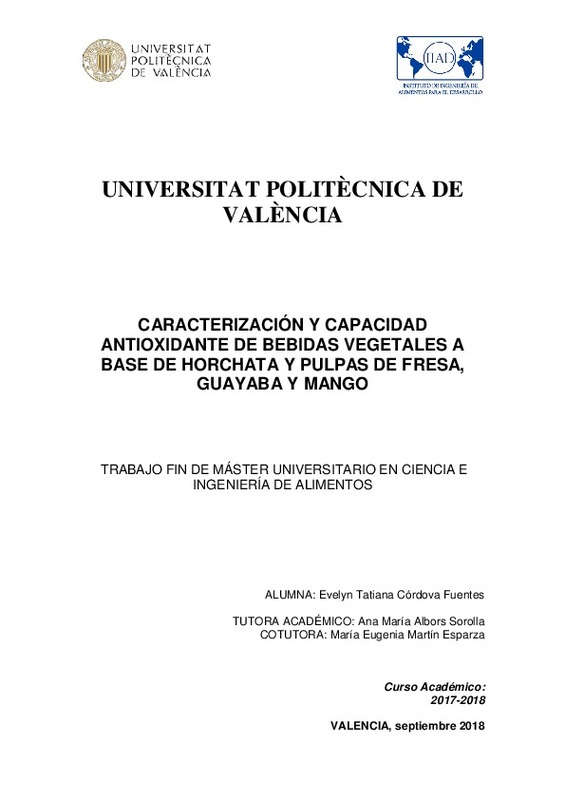|
Resumen:
|
[ES] Actualmente en el mercado se comercializan distintas bebidas vegetales a base de soja, almendra, arroz, coco, etc. Sin embargo, en la comunidad valenciana existe una bebida vegetal típica obtenida a partir de la chufa ...[+]
[ES] Actualmente en el mercado se comercializan distintas bebidas vegetales a base de soja, almendra, arroz, coco, etc. Sin embargo, en la comunidad valenciana existe una bebida vegetal típica obtenida a partir de la chufa denominada horchata. En el presente estudio se presentan bebidas vegetales a base de horchata con pulpas de fruta, ofreciendo una alternativa al consumo de este tipo de producto, que permite a la vez ampliar el mercado de la horchata. Las frutas aportarán sabor y nuevas propiedades a la horchata, haciéndola aún más nutritiva y saludable. Se diseñaron y analizaron 12 formulaciones de horchata con pulpas de fresa, guayaba y mango a distintas concentraciones. Las bebidas fueron caracterizadas mediante el análisis de pH, °Brix, color, reología y sensorial. Adicionalmente se determinó la capacidad antioxidante mediante el método de DPPH con objeto de conocer sus propiedades como alimento funcional.
El estudio ha permitido conocer la aportación de la fruta a la horchata en cuanto a su descenso de pH, ºBrix y el aumento de su capacidad antioxidante. También se observó que al adicionar mayor cantidad de fruta, la horchata se comporta como un fluido pseudoplástico. Además todas las frutas, a los niveles de concentración ensayados, aportaron a la horchata su color característico. El análisis sensorial realizado mostró una muy buena aceptación del producto por parte del consumidor.
[-]
[EN] Actually in the market commercialise distinct vegetal drinks to base of soya, almond, rice, coconut, etc. However, in the Valencian community exists a typical vegetal drink obtained from the tigernut designated ...[+]
[EN] Actually in the market commercialise distinct vegetal drinks to base of soya, almond, rice, coconut, etc. However, in the Valencian community exists a typical vegetal drink obtained from the tigernut designated ¿Horchata¿. In this work present vegetable milks of tigernut with pulps of fruit, offering an alternative to the consumption of this type of product, which allows at the same time expand the market of the horchata. The fruits will contribute flavour and new properties to this product, doing it even more nutritious and healthy. Twelve formulations of tigernut milk with pulps of strawberry, guava and mango to 10 at 25 % concentrations are designed and analysed. The drinks were characterised by means of the analysis of pH, °Brix, colour, rheology and sensory properties. Moreover the antioxidant capacity by means of the DPPH method was determined so as to know his properties like functional food.
The results of this work has allowed to know the contribution of the fruit to the tigernut milk regarding his descent of pH, ºBrix and the increase of antioxidant capacity. Moreover observed that when adding main quantity of fruit, the tigernut beverage comports like a pseudoplastic fluid. All fruits, at the levels of concentration assaid, contributed to the tigernut milks his characteristic colour and flavour. Sensory analysis made showed a very good acceptance of the products by the consumer.
[-]
|







